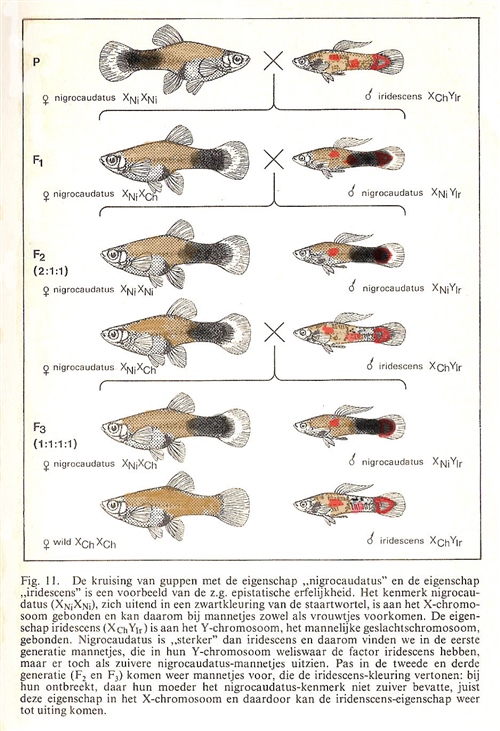Art X
How to make use of the Genetics to breed beautiful Guppies (1)
RUBRIEK: Guppy Kweek English Translation
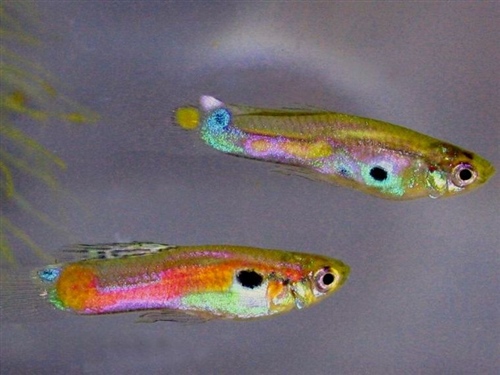


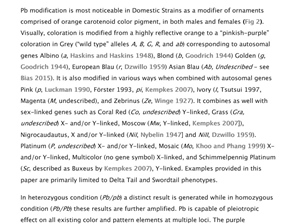

The guppy is an aquarium fish that has been bred with for over 100 years. But only the last 40 years thereof have been well documented. Considering its wide color variations, its fast reproduction and the ease of keeping and growing it, the guppy became the subject of several genetical studies in those 100 years of aquarium history. Most of those studies were conducted scientifically; that is, they had to correspond to the scientific methodology and objectives. The point is to be able to link certain genes to certain (color or pattern) properties, and to be able to reproduce this in every "lab". Here however, something is already wrong with regard to reality: genetics sup-posedly wants to "map" the complete reality, but the representation of a one-to-one allele set for one property - is too simplistic to pretend to be the complete reality.
The same problem arises, for example, with the loci in the brain: this is approxoximately true in broadly, but a living tissue interferes with organisms in a network. So, just as the neurons in the brain interact in a complex manner, the genes in the chromosomes interact in a complex manner.
So I am not impressed by those articles that have been published on the genetics of the guppy, which are actually disguised theses with the aim of familiarizing themselves with scientific methodology, or publishing a paper (that must be the case nowadays in academic environments ). What all these articles have in common, is an impressive list of reference articles, and references in a bibliography, because this methodology simply asks to "prove" the work of predecessors (even if they are completely wrong). But I talk about research, I mean something completely different: an indepen-dent study based on observation and expertise on the subject. Geneticists who engage themselves in the study of guppies "do not know" their "object" sufficiently. And guppy breeders who use the genetics, often do this to establish their name and fame. I could sum up a list with examples, but I'm not going to do this. What is important is to realize that such studies don't tell the REAL guppy story. In the first case they are far too partial; and in the second case there are too fixated on what they want to "prove".
I don't want to "prove" anything. I research, represent the conclusions of my studies not in scientific jargon and methodology, but in ordinary human language and contexts that can be checked in their value by everyone. My findings can be verified by anyone, and can even be verified by experiment. My / this research should speak for itself. And I try to tell that guppy genetics story as interesting as possible. Because most scientific essays are so boring and repetitive that an ordinary reader gives up after just two pages. Another shortcoming of them: they are cerebral and not very visual; few "illustrations". But in such a story those pricisely play a crucial role and have an important signification.
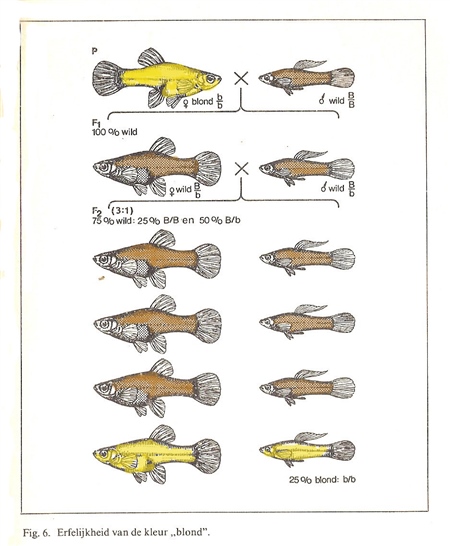
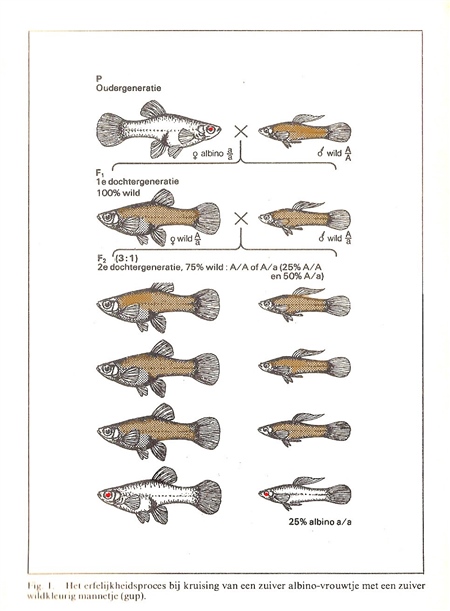
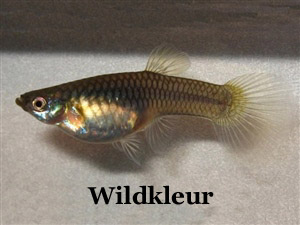
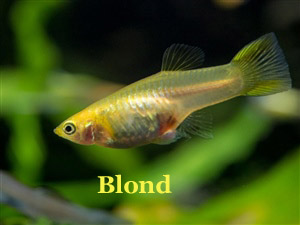

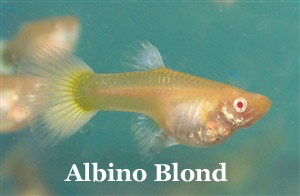

If one sticks to the essentials, a number of principles emerge in that genetics story.
The first is that of the dominance : a certain hereditary trait is always expressed in relation to other, similar traits, because it is dominant. The property it has to submit itself is called recessive. For example, in colors with the guppies, black is dominant against all other colors; and are red and orange dominant compared to green and blue.
Recessive features remain largely "hidden" until one day they suddenly become visible in an instance with a different appearance. This is because recessive traits are manifested only when they are present in "pure-bred" or homozygous state, and are no longer masked by dominant traits . In this context, one speaks of the difference between phenotype = what one can see externally, and genotype = what is present internally as genetic material. "Bastards" or heterozygous animals, have always mixed genes for a particular trait.
For example, a number of guppies have emerged over the years, with a different ground color than the gray-brownish wild color. Like blond for example: a yellowish-gold glow over the body; not to be confused with the real gold color (gold) that is determined by other genes on some parts of the body. White: a whitish shadow all over the body; not to be confused with the full color white on parts of the body and fins. Blue: a gray-bluish sheen all over the body; not to be confused with the glossy blue of irido-phores. And albino: a kind of translucent white all over the body due to the absence of pigment (which makes the eyes red). These recessive traits are easy to recognize because they occur uniformly throughout the full body, and are easy to cross with, because they are determined and inheri-ted by only two pairs of genes.
In the figures centrally above, you see such two examples, where a blond resp. an albino type is crossed back with a wild color. The parents (P) initially show only wild color as progeny (F1). The recessive color blond resp. albino is masked, and only shows up at a further crossing (F2) in a percentage of 1 in 4, or 25%. This is because each individual has a pair of genes for one trait, which lie on a chromosome PAIR in the nucleus: one from the mother, and one from the father. Therefrom the notation with double genes. However, in the formation of ova and spermatozoa, those coiled DNA strands are disassembled again, so that they only have ONE specific chromosomes (from in total 23). In this case: with the gene B or b, or with gene A or a. At fertilization and the formation of offspring, those chromosome pairs reunite, so the children get again one of their, and one of their mother. Note: dominant genes are written in capital letters, and recessive genes in lowercase letters.
Crossings that relate to one single gene pair are, of course the simplest.
The way in which a certain trait is passed on by the genes, was first found and by the monk-botanist Georg Mendel. And we owe the investigation of the different and specific pigment layers, and the discovery of sex-linked inhereitence in guppies, to M. Dzwillo . The photos below illustrate the difference in pigmentation.
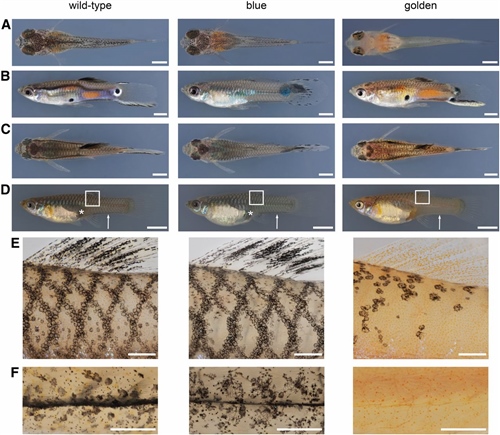
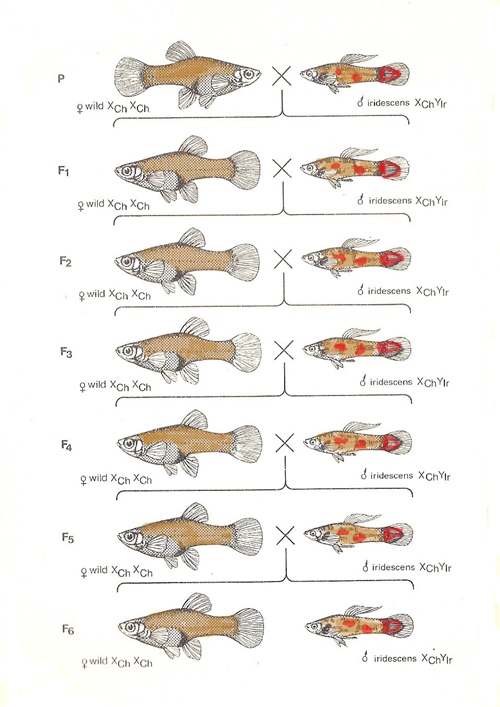
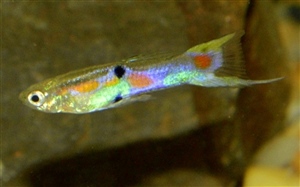
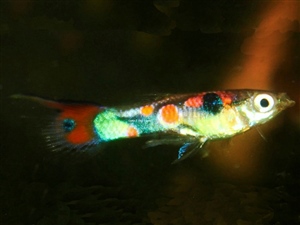
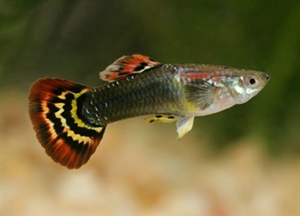


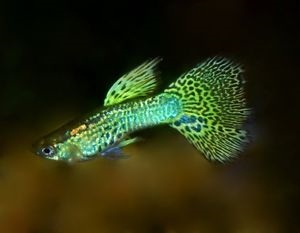

Such couple are the two sex chromosomes : the female chromosome X and the male chromosome Y. They not only provide two different sexes, but also make the indiduals look different (what is called sexual difor-mism). Male individuals have an X chromosome from their mother and a Y chromosome from their father. And females have an X chromosome from their mother and an X chromosome from their father. Therefore, the genetic sex code is XX for women and XY for men. When a certain trait is linked to a gender, one speaks with a difficult name about sex-linked inheritance . This simply means that the inheritance follows exclusively the sex line: the male or the female. Male guppies have colors on their bodies, and females do not. Males have developed tail and dorsal fins, and females (initially) do not. These genes therefore lie on the Y chromosome.
Such a sex-linked inheritance makes breeding very easy, but gives also certain problems. Easy because one keeps getting "the same result": it is as if the sons are duplicates of their fathers and grandfathers. The figure above centrally illustrates this: the property of having a red iridescent caudal spot - what was then called (1960) type (rubra) iridescens - lies on the Y chromosome, and is therefore given from father to . No matter how many generations one mates one after the other with a wild-colored female (here 6 generations), the genotype and phenotype of the obtained males remain the same.
Another attribute associated with the Y chromosome is the filigree or snakeskin motif . It means that one will have to introduce OTHER males in his breeding lines if one wants to see changes appear.
A characteristic attributed to the X chromosome was the nigrocaudatus or tuxedo: once the halfblack is introduced in its culture, it is difficult to get it out. After all, all females will not only carry the tuxedo gene with one or two Xn genes, but the males will also receive an Xn gene from their mother, and because this is dominant over the wild color, they will also display a black tuxedo.
Below centrally you can see what happens when one crosses such a Tuxedo female with a red triangle. The black of the Tuxedo - with the old name Ni of Nigrocaudatus - is dominant over the red, so that all descendants will display a tuxedo. The males with a bit of red that shine through the presence of their father's Y-red. And the females of F1 with a little less black in the tail fins due to the "normal" X of their mother.

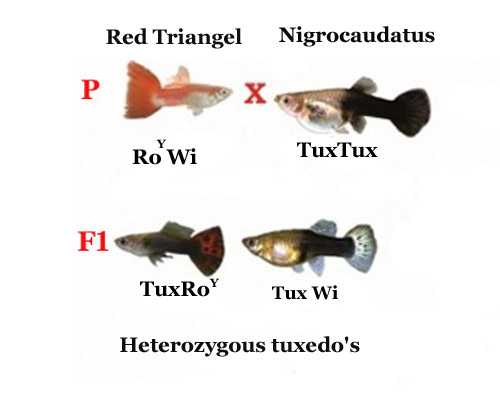
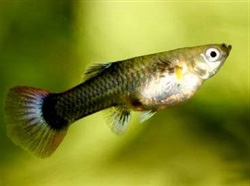

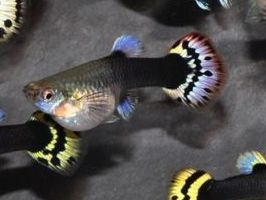
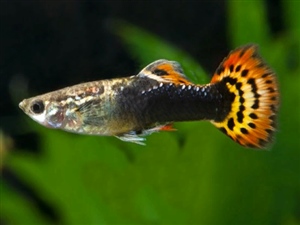
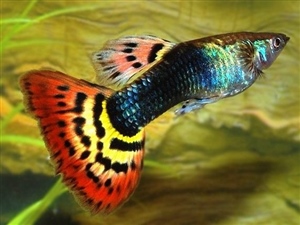
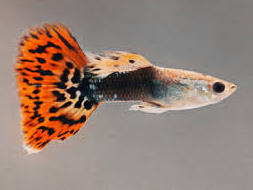


Note the confusing depiction X-Ni and X-ni for tuxedo and non-tuxedo (recessive so with lower case letters). In this context, one really means: THESE genes on the X chromosome that relate to the property tuxedo. The same happens for genes located on the Y-chromosome. Actually, I find this spelling clumsy, unnecessary and confusing. This is inconvenient because in the end you have to put a lot of notes on those X and Y. Superfluous, because 50% females and 50% males of certain combinations always occur (theoretical), so that this writing is not really needed. And confusing, because one risks confusing gene with chromosome, and will not be able to see the final result with Y's with many transcriptions. It is better to give the genes a name directly for the trait of which they are a carrier, and to use an abbreviation that refers to that. Such as Tux for tuxedo, Wi for wild color and Ro for red triangle. If necessary, one can put the Y as a small exponent at the top to mention that it is sex-linked (so the opposite of what one now usually does).
Because my experience has taught me that this distinction is not very relevant. Primo because over time often the opposite sex also appears to have that trait - as is the case with snakeskin and the developed tail fin for example -. And secondly, because in just as many other cases, what con-cerns colors on the body in females for example, they are most of the times present, but are suppressed in their effect. As a carrier of the offspring, the females must, after all, be able to maintain that wild protective color as a priority. When certain traits are NOT on the sex chromosomes, and are still inherited, one speaks of autosomal inheritance. A difficult word that basically just means that those genes are situated on the normal (other 22 pairs) chromosomes, and thus occur in both males AND females. So that strict distinction between so-called sexual and autosomal inheritance is superfluous in many cases, such as this one here: genes always lie on one of the 23 pairs of chromosomes. It is better to focus on the genes themsel-ves than on which chromosome they lie.
What you do need to know is when you put 2 factors together, which is the dominant of the two. And that immediately becomes clear in the F1 off-spring. So I did that same cross between a tuxedo female and a red triangle male with a different "subtitle" that would better convince me. Take a look at both performances from above, and make your own judgment which of the two you find the most illustrative and clearest.
I conclude this first part with a variant of this cross which I found in a booklet that I have cherished since my youth as a precious jewel: "Heredity for the aquarium owner" by J.H.Schröder .
